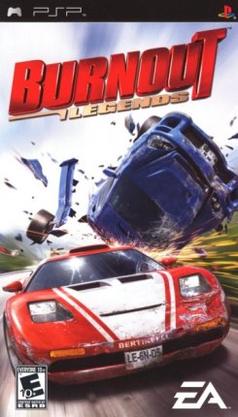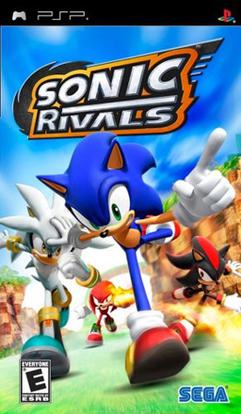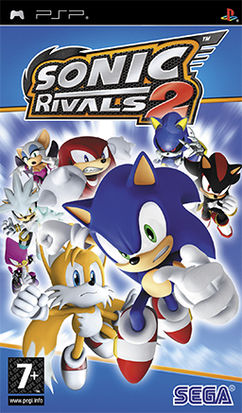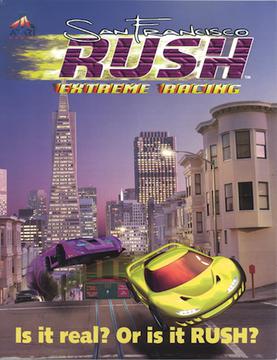The Initial D video game series, also known as Initial D Arcade Stage, is an arcade racing game series developed by Sega, based on the anime and manga series Initial D. In the United States and Europe, the game series is simply known as Initial D.

Need for Speed: Underground 2 is a 2004 racing video game developed by EA Black Box and published by Electronic Arts. It is the eighth installment in the Need for Speed series and the direct sequel to Need for Speed: Underground. It was developed for Microsoft Windows, GameCube, PlayStation 2, and Xbox. Game Boy Advance and Nintendo DS versions were developed by Pocketeers, and a PlayStation Portable version, titled Need for Speed: Underground Rivals, was developed by Team Fusion. Another version for mobile phones was also developed. Like its predecessor, it was also commercially successful, selling around 11 million copies worldwide and breaking sales records in the United Kingdom.

Midnight Club 3: Dub Edition is a 2005 racing video game developed by Rockstar San Diego and published by Rockstar Games. It is the third installment in the Midnight Club series. Like previous installments in the series, the game is an arcade-style racer and focuses on wild, high-speed racing, rather than realistic physics and driving. The name is derived from a partnership between Rockstar and DUB Magazine, which features heavily in the game in the form of DUB-sponsored races and DUB-customized vehicles as prizes.

Burnout Legends is a racing video game developed by Criterion Games and published by Electronic Arts for PlayStation Portable. The game features many of the tracks and gameplay modes from the first three Burnout titles but repackaged for the handheld format. Many of the gameplay modes are similar to Burnout 3: Takedown using a mixture of old and new tracks. The Nintendo DS port was developed by Visual Impact.
Rush is a series of racing video games developed by American-based company Atari Games and published by Atari Games and Midway Games for home consoles. The series debuted worldwide in 1996. The games consist mainly of racing with various cars on various tracks, and to some extent, including stunts in races. Since L.A. Rush the series has adopted its street racing atmosphere.

Ridge Racer 6 is a racing game by Namco released in 2005. It was the sixth console game in the Ridge Racer series but unlike the previous mainline entries, which were released for PlayStation consoles, this entry was released exclusively as a launch title for the Xbox 360. In a similar fashion to the first Ridge Racer on PS1, Ridge Racer V on PlayStation 2, Ridge Racer(s) on PlayStation Portable and eventually Ridge Racer 7 on PlayStation 3. All are exclusive launch titles for their respective consoles.

OutRun 2006: Coast 2 Coast is a racing game developed by Sumo Digital and published in 2006 by Sega. It is the 9th title in the series, and the final one to have a physical release. Outrun 2006 is an updated version of OutRun 2. The game is split into two parts: a conversion of OutRun 2 SP and "Coast 2 Coast", which includes single-player races and challenges, and local network and internet multiplayer.

Cars is a 2006 adventure racing game published by THQ. The game is based on the 2006 film of the same name. It was released for the PlayStation 2, GameCube, Xbox, Microsoft Windows, Game Boy Advance, Nintendo DS, and PlayStation Portable in June 2006, with versions for the Xbox 360 and Wii released later that year. The Wii version includes functionality geared towards its Wii Remote controller and was a launch game for the system. Taking place after the events of the film, the game follows Lightning McQueen as he participates in the new racing season with his goal set on finally winning the Piston Cup. While doing so, he races and trains with the local community of Radiator Springs.

Sonic Rivals is a 2006 action-racing video game developed by Backbone Entertainment and Sega Studio USA, and published by Sega for the PlayStation Portable (PSP); it is a game in the Sonic the Hedgehog series, and follows the heroes needing to stop Doctor Eggman Nega from turning everyone and the world into cards. The gameplay involves racing against other characters to get to the goal before them, as well as defeating the boss before the opponent does.

Need for Speed: Carbon is a 2006 racing video game and the tenth installment in the Need for Speed series. Developed by EA Black Box, Rovio Mobile and published by Electronic Arts, it was released on October 31, 2006, for the PlayStation 2, PlayStation 3, Xbox, Xbox 360, GameCube, Windows, and Mac OS X, and on November 19, 2006 as a launch title for the Wii and in 2008 for arcade cabinets. The game sees players conducting illegal street races within the fictional city of Palmont City, with the game's main story taking place after the events of Need for Speed: Most Wanted and focusing on the player's character taking control of the city from various street-racing gangs. While the gameplay is similar to its predecessor, Carbon introduced a number of new features, including crews and racing wingmen, Touge-styled racing events, and greater customization options.

Stunt Racer 64 is a racing video game developed by Boss Studios and published by Midway. The game was released exclusively in North America on October 3, 2000 for the Nintendo 64.

Burnout Dominator is a 2007 racing video game developed by EA UK and published by Electronic Arts for PlayStation 2 and PlayStation Portable. It retains the core gameplay of the series, as players race at top speeds through dozens of World Tour events testing "reckless skill-based" driving techniques.

Ridge Racer 2, released in Japan as Ridge Racers 2, is an arcade-style racing game developed by Namco Bandai Games for the PlayStation Portable hand-held console, marking the 14th release in the Ridge Racer series and also the sequel to the PSP launch title Ridge Racer. It saw release in Japan on 14 September 2006, followed by its 13 October European launch and 19 October release in Australia. The original North American release was cancelled. On 20 December 2022, Ridge Racer 2 was made available worldwide to download on PlayStation 4 and PlayStation 5 as part of the PlayStation Plus Premium subscription service.

Formula One: Built to Win is a 1990 racing video game for the Nintendo Entertainment System developed by Winky Soft and published by SETA Corporation.

Midnight Club: Los Angeles is a 2008 racing video game developed by Rockstar San Diego and published by Rockstar Games. It is the fourth and final installment in the Midnight Club series before it was discontinued in January 2010. The game features 43 cars and 3 motorcycles. The open world map of Los Angeles is the size of all three cities from the previous installments combined. After several delays, Midnight Club: Los Angeles was released in October 2008.

Sonic Rivals 2 is a 2007 racing video game, the sequel to the 2006 game Sonic Rivals. The game was developed by Backbone Entertainment and supervised by Sega Studio USA, for the PlayStation Portable handheld video game console. Sonic Rivals 2 was released across November and December 2007. It received "mixed or average" reviews from critics.

San Francisco Rush: Extreme Racing is a video game developed and published by Atari Games. This game was first released in arcades in 1996 and was ported to Nintendo 64 in 1997 and the PlayStation in 1998. San Francisco Rush: Extreme Racing is the first game in the Rush series.

Need for Speed: Most Wanted is a 2005 racing video game, and the ninth installment in the Need for Speed series. Developed by EA Canada and EA Black Box and published by Electronic Arts, it was released in November 2005 for PlayStation 2, Xbox, GameCube, Nintendo DS, Microsoft Windows, Game Boy Advance and Xbox 360. An additional version, Need for Speed: Most Wanted 5-1-0, was released in the same year for PlayStation Portable. The game focuses on street racing-oriented gameplay involving a selection of events and racing circuits found within the fictional city of Rockport, with the game's main story involving players taking on the role of a street racer who must compete against 15 of the city's most elite street racers to become the most wanted racer of the group, in the process seeking revenge against one of the groups who took their car and developing a feud with the city's police department.

Hot Wheels Ultimate Racing is a 2007 racing video game developed by Italian company Raylight Studios and published by DSI Games for the PlayStation Portable (PSP) exclusively. The game is based on the Hot Wheels toy line which manufactured by Mattel.

Armada F/X Racers is a 2000 video game for the Game Boy Color, developed by Metropolis Digital Inc. and published by Metro3D. The game is a futuristic-themed racing game based on the 1999 Dreamcast game Armada.


















